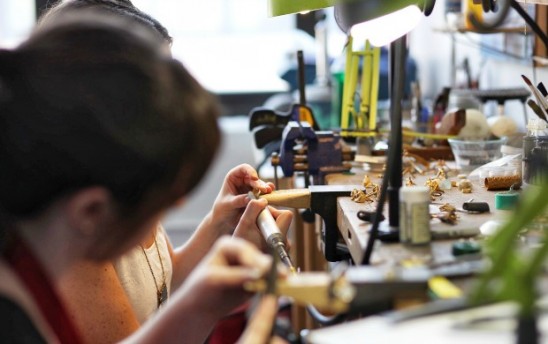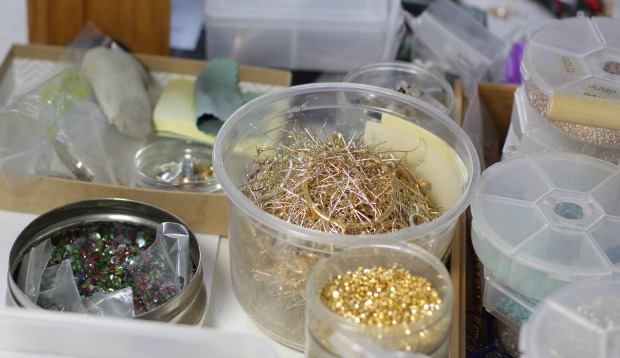As the Senior Production Manager here at UncommonGoods, my job is to oversee the connection of design ideas with manufacturing resources to create new products.
Thomas Edison claimed that genius is one percent inspiration and ninety-nine percent perspiration. From my experience, product development warrants a formula of its own. To carry an idea through to a finished product you should start with a spark of inspiration, then add in equal parts diligence and thoughtfulness, especially when it comes to sourcing.
I’ve pulled together the following considerations for responsible material and supplier sourcing inspired by my experience partnering with our makers on new product development. I hope these thoughts will help other small business owners navigate the rough waters of sourcing.
1. Know your materials
Now that you have a sense for what you’re creating, what materials will be used in making your product?
Things to think about
- Have you considered all possibilities?
- Are you being conscious of how your materials will perform under various conditions?
- Are you giving thought to the materials’ impact on the environment?
- Are the materials prone to irregularity that you’ll need to account for and adequately convey to your customer?
- Do the components and materials you plan to work with require expensive tooling?
- Are you working with materials that strike the right balance between cost and quality?
- How easy can your materials be traced back to their origins, when it comes time to test for safety?
Tracing your components and materials back as far as you can in the supply chain, regardless of complexity, helps you understand the nature of your product and anticipate potential issues or considerations.
2. Know your suppliers
Research before you decide on a supplier. You’re not only acquiring materials, you’re acquiring a partner. Your supplier can make or break the success of your product, and an unreliable supplier can hamper your growth in a big way. An out of stock or discontinued material or component can force you to suspend production entirely.
Things to think about
- What does your supplier’s inventory levels look like?
- How often do they get replenished?
- What are their turnaround times and chances of discontinue?
- Get to know the person you are buying your materials from. Are you just a number to them or do they value you as a customer regardless of how much quantity you buy?
- Do they have time to answer your questions?
This is helpful information that will give you an idea of how much your supplier knows about the component they will be selling you. Unknowns should be a big red flag. Make sure your suppliers understand how you plan on using the component in case there are considerations to which you’re not privy (i.e. weather-resistance for outdoor items). Establish your standards early! You should not be at the mercy of a supplier whose quality concerns are far below your own. You should either get on the same page or find someone else who can accommodate your needs.
Be sure to also educate yourself on the materials you are using and what is reasonable to expect from your supplier. Find Internet resources or someone you trust with experience in the materials or production process you’re getting into. Ultimately, ensure that you and your supplier have an understanding of the consistency of materials to be expected. Do your due diligence and shop around before you make a supply chain decision. This will also help you develop an understanding of what the market value of a component is, rather than taking what the first supplier tells you at face-value. It’s advisable to always have a backup plan, if possible, in case a supplier has inventory issues and cannot deliver a critical component. Ask questions throughout the life of the product, not just during the beginning stages and never assume a supplier will proactively provide critical information about availability.
3. Test your materials for safety
Glazes, paints and other applied coatings may contain harmful chemicals like lead or cadmium. Rubber parts may contain chemicals regulated by the government like phthalates. Reclaimed materials can contain who knows what. Guess what? You need to be the “who” that knows “what.” Do your research and find out what the components in your products are all the way down to the coatings and metals. Research what hazardous chemicals may be associated with those elements. In many cases, you are the last line of defense between a harmful product and a customer. Never assume that anyone you’re working with (that goes for suppliers and customers) is going to adequately manage and mitigate that risk or do the research on your behalf. Identifying elements on a chemical level and testing your product if there is any uncertainty is crucial to ensuring the safety of both the end-user and the maker.
Things to think about
- Products with applied coating: If you are buying an applied coating, make sure you consult the manufacturer to understand what went into the coating. Ask for Material Safety Data Sheets (MSDS) and lab reports to ensure both you and your suppliers are doing your due diligence. Just because they don’t know about current legislation doesn’t mean their products are exempt from those standards.
- Pre-coated products: Ensure that your supplier has information on the coating.
- Products with reclaimed material: Work with a lab to establish recommended tests based on the materials involved and never assume that the test results of one unit will be representative of every like item, unless you are controlling for materials and production environment, which in reclaimed product is often very hard to know for sure.
Familiarize yourself with the existing and ever-changing safety legislation to ensure that you are in compliance. It is important that you know where your product is being sold and what legislation it might be subject to. Familiarize yourself with the materials you’re using so you understand the implications of their inclusion. Be an expert on your product. Your knowledge and understanding of your components will help you work with your customer in ensuring your product is safe and gets to market as quickly as possible. Furthermore, understanding your materials will help you to better and more transparently market your product.
4. Test your materials and product for performance
Put yourself in the shoes of a customer and how they might use and interact with your product.
Things to think about
- Do your materials perform well for intended use?
- Are your material durable?
- Now that your item is developed, how do your materials interact with one another?
- Will your materials last? Nothing lasts forever, but a customer has a right to expect to get their money’s worth. This is also a great opportunity to get feedback on functionality from people who aren’t as close to your product as you are. A fresh perspective from a friend or colleague helps to diminish blind spots that may have developed from your intimacy with the product.
These are some general jumping off points for questions you should be asking yourself and considerations you should be thinking about throughout the development process. The questions and considerations don’t get put to sleep once your product is brought to market. In terms of product safety, legislation is constantly changing. In terms of material consistency, products may be discontinued and new components may need to be vetted and introduced. Suppliers may come and go. Do your homework. Ask questions. Stay engaged. Know your product. Empathy for the folks who will ultimately use and enjoy your product should be the guiding force behind your work and will help to create a product that is safe, that delights and that creates a meaningful impact for your customers.
We are always looking for makers and manufacturers to partner with on developing new products! Learn how to work with our product development team here.






2 Comments
It definitely is a good decision to research your potential suppliers before you select which one to go with. It could be very important to know if your supplier is looking to create synergy or to have a transactional relationship. Selecting a steel supplier that is looking to synergize could help your business be more successful.
I think it is important that the materials be able to be traced back to their origins through the testing. It would make sense to verify the product quality so that it is safe to work with the materials. I’ll have to consider your material tips in the future if I ever have stuff shipped in.